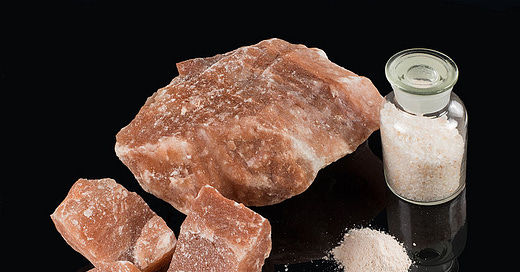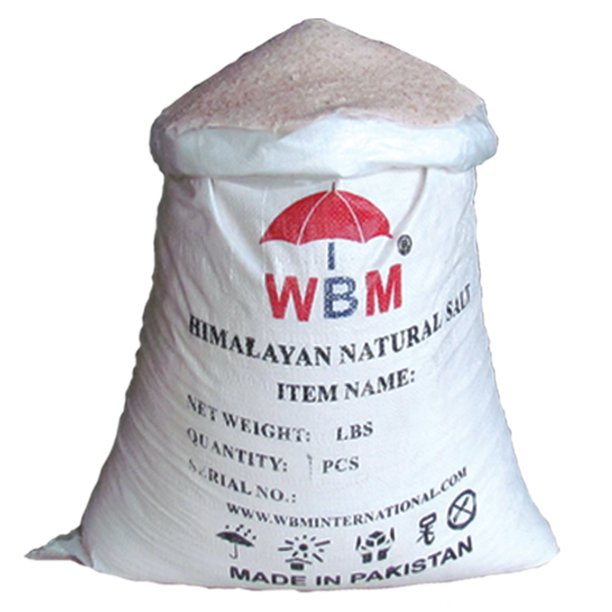Yes, There Are Microplastics in Your Himalayan Sea Salt.
Microplastics are everywhere - even where you'd least suspect.
On my YouTube Channel I posted a video discussing the recipe for something called “Snake Juice” - basically an electrolyte solution used when fasting.
During the video I suggested that regular, plain old table salt could be used in the recipe in lieu of the more fashionable Himalayan sea salt.
The comment wasn’t intended to cause controversy. Hell, it was more of something said off-hand than anything else.
Sodium chloride is sodium chloride - who could argue with that?
Well, turns out a lot of people are heavily invested in the type of salt they’re consuming and are more than willing to fill up your comments section and your email inbox with messages and arguments extoling the virtues of their favorite brand of rock salt.
As I sifted through the often long and poorly written comments & emails I noticed a trend.
Most of the arguments fell into one of two categories:
1) Various Sea/Rock Salts are superior to iodized table salt due to the fact they aren’t “processed” and still contain “trace minerals” that are nutritionally valuable.
2) Iodized Table Salt contains microplastics not found in Sea Salts or Rock Salts.
For today’s article I’m going to focus on category 2, the microplastic issue. I’ll address the “trace minerals” argument and why it’s dumb in another post.
Here’s the Thing About Microplastics
The term microplastic refers to plastic pollutants that are typically smaller than a sesame seed - usually much, much smaller.
You may or may not already be aware of this, but microplastics are a big problem and they’re a big problem for two reasons.
Firstly, microplastics are damaging to your health. These tiny shards of plastic embed themselves into the tissues of organisms that ingest them (particularly in the tissues of the digestive tract). It is known that plastics can act as endocrine disruptors in humans and when these plastics become lodged in one’s digestive tract it can lead to inflammatory bowel disease.
Nasty stuff.
Secondly, microplastics are literally EVERYWHERE. From the water we drink, to the food we eat, and even the air we breathe, microplastics are there.
We have, as a society, become so reliant on plastics in our everyday lives that plastic pollution is nearly inescapable.
How Does All of This Apply to Salt?
Getting back to Himalayan sea salts, lets look at why people believe their trendy salts DON’T have microplastics in them.
The argument goes something like this:
Himalayan sea salts have been locked away under mountains, in geological formations, for millions of years before they are mined out for our consumption.
Because they’ve been locked away for millions of years its “impossible’ for them to have been polluted with microplastics since plastics weren’t invented until the mid 1800s and weren’t really in widespread use until the 20th century.
It’s not a wholly illogical conclusion EXCEPT for the fact that it ignores some very important confounding factors. Namely, that once the Himalayan sea salt is mined out of the ground they DO become exposed to microplastics via several potential sources of contamination like: polypropylene bulk packaging, synthetic fibers from garments worn by workers, and plastic consumer packaging.
Now, I’m sure you’re saying to yourself at this point, “Where’s the proof?”
Funny you should ask.
Multiple studies (HERE, HERE, and HERE) have all shown the same thing: nearly all of these fancy “sea” salts - including Himalayan Sea Salt - are contaminated with microplastics.

In these studies, the researchers looked at a variety of “high end” salts and used FTIR spectroscopy to determine the amount and type of microplastic pollutants found within.
It’s important to understand that researchers in these studies used the term “Himalayan Sea Salt” as well as “Pakistani Rock Salt” to describe what is the exact same product. So, when you go looking through links above you should be on the look out for both terms.
How Did This Happen?
Honestly, it’s hard to determine the exact vector of contamination. The researchers in these studies put forth a few ideas on how it may have happened, but with the ubiquitous nature of plastics in our everyday lives it really is difficult to pinpoint exactly how the plastics end up in the Himalayan salt.
With the sea salts its easy - we pollute our oceans and rivers with various types of plastic waste. We then turn around and pull salt from the sea and *bam* plastic in your salt.
Himalayan Salt is different. It needs to be dug up. It’s in the ground (and has been for millions of years) and hasn’t been in contact with any polluted waters.
So, how the hell did the microplastics end up in the Himalayan sea salt being sold to consumers? Here’s my guess:
Researchers have shown over 70% of all microplastics in salts are of two different types: polypropylene and polyethylene.
What’s interesting about polypropylene is that one of its more common uses is for bags used to ship bulk goods. Theses bags come in various sizes and are made of woven fibers of polypropylene plastic.
And wouldn’t you know it, woven fiber polypropylene bags are EXACTLY what’s used to ship Himalayan sea salt in bulk. Take a look at the pics below.

I can tell you as someone who has worked with tens of thousands of polypropylene bags during my time in the freight/logistics industry, these bags will fray and scratch up pretty easily during the shipping process. Especially when filled with something as abrasive as rock salt. All that fraying and scratching will produce microplastic particles.
As for polyethylene, we use that for all kinds of consumer packaging and other consumer uses. Your reusable grocery bag is polyethylene. Even the non reusable grocery bags are made of the stuff.
But polyethylene’s main use is, again, in consumer packaging.
If you’ve ever bought Himalayan sea salt in a bag, then the bag is most likely polyethylene.
Polyethylene isn’t exactly abrasion resistant either.
So, to answer the question of, “How did microplastics end up in Himalayan sea salt” I think our most likely culprits are the polypropylene and polyethylene bags that are being used to ship and package Himalayan sea salt.
BUT it could come from anywhere along route between mining and store shelves.
Conclusion -
Unfortunately, microplastics are everywhere.
And because our use of plastic isn’t going away any time soon, microplastics aren’t going away anytime soon either.
Don’t be surprised when we continue to find this garbage everywhere - even where it’s not supposed to be.
Citations -
Global Pattern of Microplastics (MPs) in Commercial Food-Grade Salts
Microplastic pollution in commercial salt for human consumption
Anthropogenic contamination of tap water, beer, and sea salt
The presence of microplastics in commercial salts from different countries
https://en.wikipedia.org/wiki/Microplastics#Where_microplastics_can_be_found











